Financial Performance Management Report: Decision Making & KPIs
VerifiedAdded on 2023/01/04
|11
|3866
|68
Report
AI Summary
This report provides a comprehensive analysis of financial performance management, addressing the critical aspects of environmental costs, decision-making processes, and the significance of key performance indicators (KPIs). Part 1 delves into the challenges businesses face in managing environmental costs, exploring various accounting methods and their implications. The report evaluates the impact of environmental management accounting, cost-benefit analysis, and techniques like activity-based costing. Part 2 focuses on the tools used by management accountants to provide crucial information for long-term business success. It examines decision-making processes, planning tools such as forecasting, contingency planning, and goal setting. The report also emphasizes the role of KPIs in enhancing financial performance and achieving financial sustainability, providing insights into budgetary control systems and their evaluation. Overall, the report aims to provide a robust understanding of financial performance management and its practical applications.
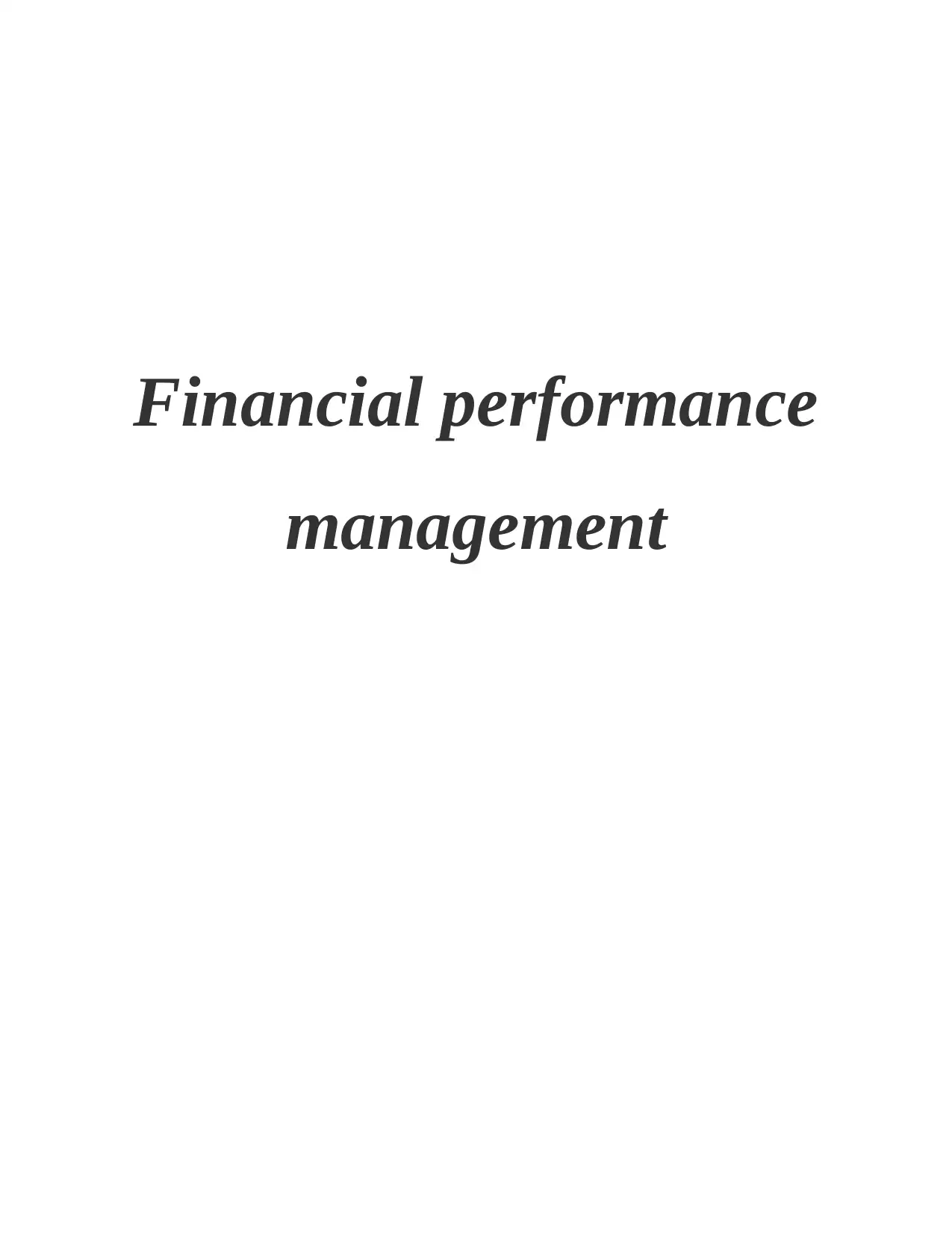
Financial performance
management
management
Paraphrase This Document
Need a fresh take? Get an instant paraphrase of this document with our AI Paraphraser
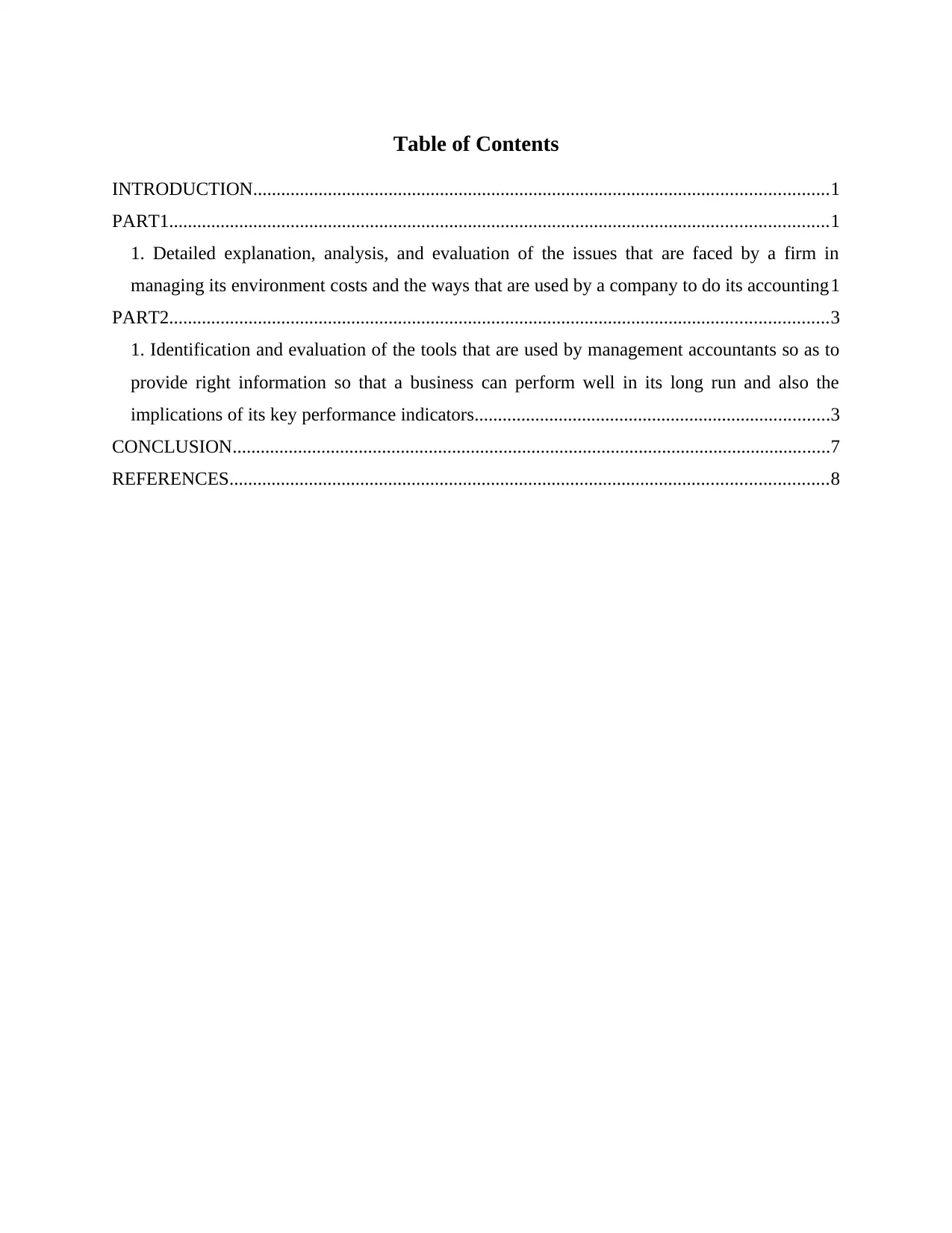
Table of Contents
INTRODUCTION...........................................................................................................................1
PART1.............................................................................................................................................1
1. Detailed explanation, analysis, and evaluation of the issues that are faced by a firm in
managing its environment costs and the ways that are used by a company to do its accounting1
PART2.............................................................................................................................................3
1. Identification and evaluation of the tools that are used by management accountants so as to
provide right information so that a business can perform well in its long run and also the
implications of its key performance indicators............................................................................3
CONCLUSION................................................................................................................................7
REFERENCES................................................................................................................................8
INTRODUCTION...........................................................................................................................1
PART1.............................................................................................................................................1
1. Detailed explanation, analysis, and evaluation of the issues that are faced by a firm in
managing its environment costs and the ways that are used by a company to do its accounting1
PART2.............................................................................................................................................3
1. Identification and evaluation of the tools that are used by management accountants so as to
provide right information so that a business can perform well in its long run and also the
implications of its key performance indicators............................................................................3
CONCLUSION................................................................................................................................7
REFERENCES................................................................................................................................8
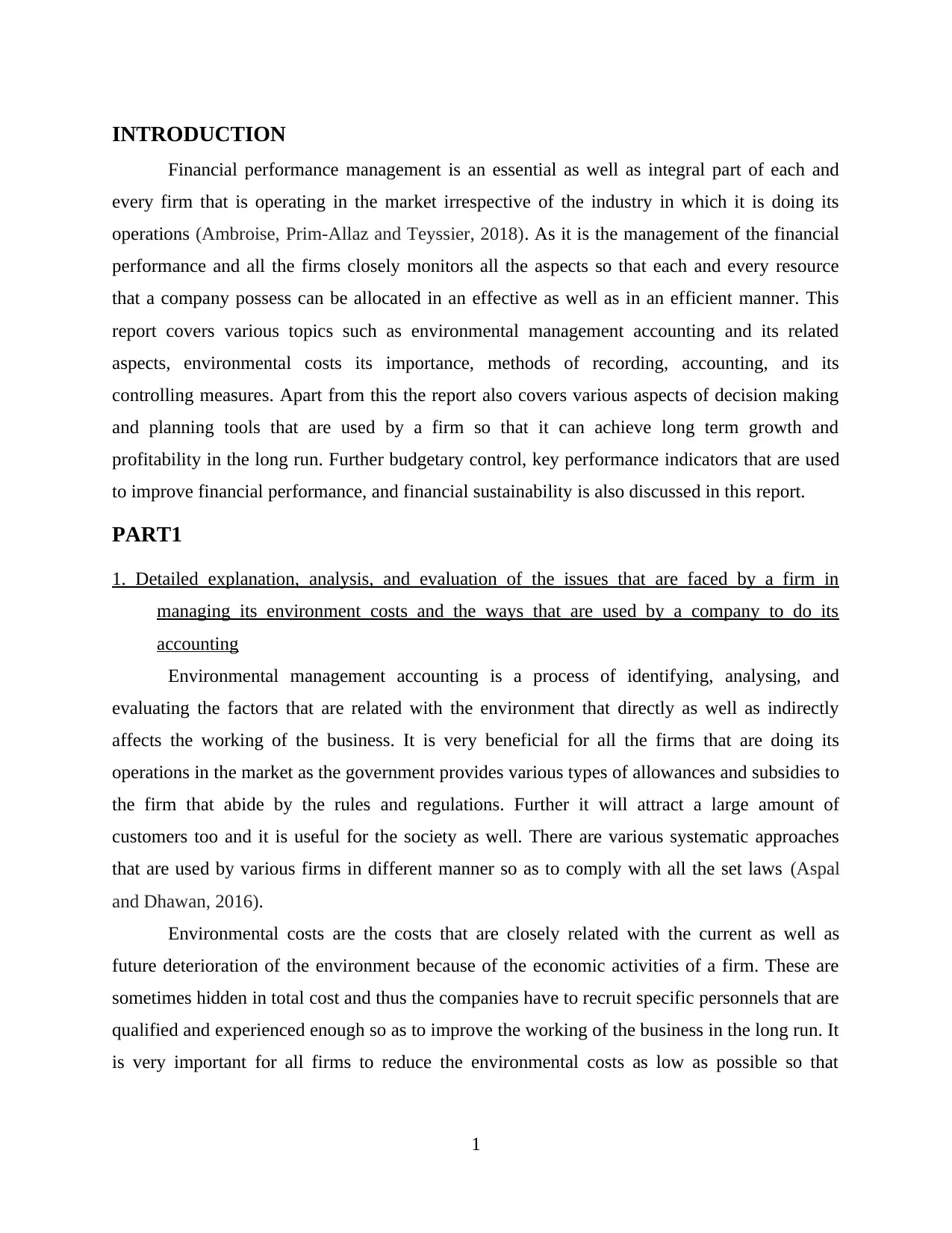
INTRODUCTION
Financial performance management is an essential as well as integral part of each and
every firm that is operating in the market irrespective of the industry in which it is doing its
operations (Ambroise, Prim-Allaz and Teyssier, 2018). As it is the management of the financial
performance and all the firms closely monitors all the aspects so that each and every resource
that a company possess can be allocated in an effective as well as in an efficient manner. This
report covers various topics such as environmental management accounting and its related
aspects, environmental costs its importance, methods of recording, accounting, and its
controlling measures. Apart from this the report also covers various aspects of decision making
and planning tools that are used by a firm so that it can achieve long term growth and
profitability in the long run. Further budgetary control, key performance indicators that are used
to improve financial performance, and financial sustainability is also discussed in this report.
PART1
1. Detailed explanation, analysis, and evaluation of the issues that are faced by a firm in
managing its environment costs and the ways that are used by a company to do its
accounting
Environmental management accounting is a process of identifying, analysing, and
evaluating the factors that are related with the environment that directly as well as indirectly
affects the working of the business. It is very beneficial for all the firms that are doing its
operations in the market as the government provides various types of allowances and subsidies to
the firm that abide by the rules and regulations. Further it will attract a large amount of
customers too and it is useful for the society as well. There are various systematic approaches
that are used by various firms in different manner so as to comply with all the set laws (Aspal
and Dhawan, 2016).
Environmental costs are the costs that are closely related with the current as well as
future deterioration of the environment because of the economic activities of a firm. These are
sometimes hidden in total cost and thus the companies have to recruit specific personnels that are
qualified and experienced enough so as to improve the working of the business in the long run. It
is very important for all firms to reduce the environmental costs as low as possible so that
1
Financial performance management is an essential as well as integral part of each and
every firm that is operating in the market irrespective of the industry in which it is doing its
operations (Ambroise, Prim-Allaz and Teyssier, 2018). As it is the management of the financial
performance and all the firms closely monitors all the aspects so that each and every resource
that a company possess can be allocated in an effective as well as in an efficient manner. This
report covers various topics such as environmental management accounting and its related
aspects, environmental costs its importance, methods of recording, accounting, and its
controlling measures. Apart from this the report also covers various aspects of decision making
and planning tools that are used by a firm so that it can achieve long term growth and
profitability in the long run. Further budgetary control, key performance indicators that are used
to improve financial performance, and financial sustainability is also discussed in this report.
PART1
1. Detailed explanation, analysis, and evaluation of the issues that are faced by a firm in
managing its environment costs and the ways that are used by a company to do its
accounting
Environmental management accounting is a process of identifying, analysing, and
evaluating the factors that are related with the environment that directly as well as indirectly
affects the working of the business. It is very beneficial for all the firms that are doing its
operations in the market as the government provides various types of allowances and subsidies to
the firm that abide by the rules and regulations. Further it will attract a large amount of
customers too and it is useful for the society as well. There are various systematic approaches
that are used by various firms in different manner so as to comply with all the set laws (Aspal
and Dhawan, 2016).
Environmental costs are the costs that are closely related with the current as well as
future deterioration of the environment because of the economic activities of a firm. These are
sometimes hidden in total cost and thus the companies have to recruit specific personnels that are
qualified and experienced enough so as to improve the working of the business in the long run. It
is very important for all firms to reduce the environmental costs as low as possible so that
1
⊘ This is a preview!⊘
Do you want full access?
Subscribe today to unlock all pages.

Trusted by 1+ million students worldwide
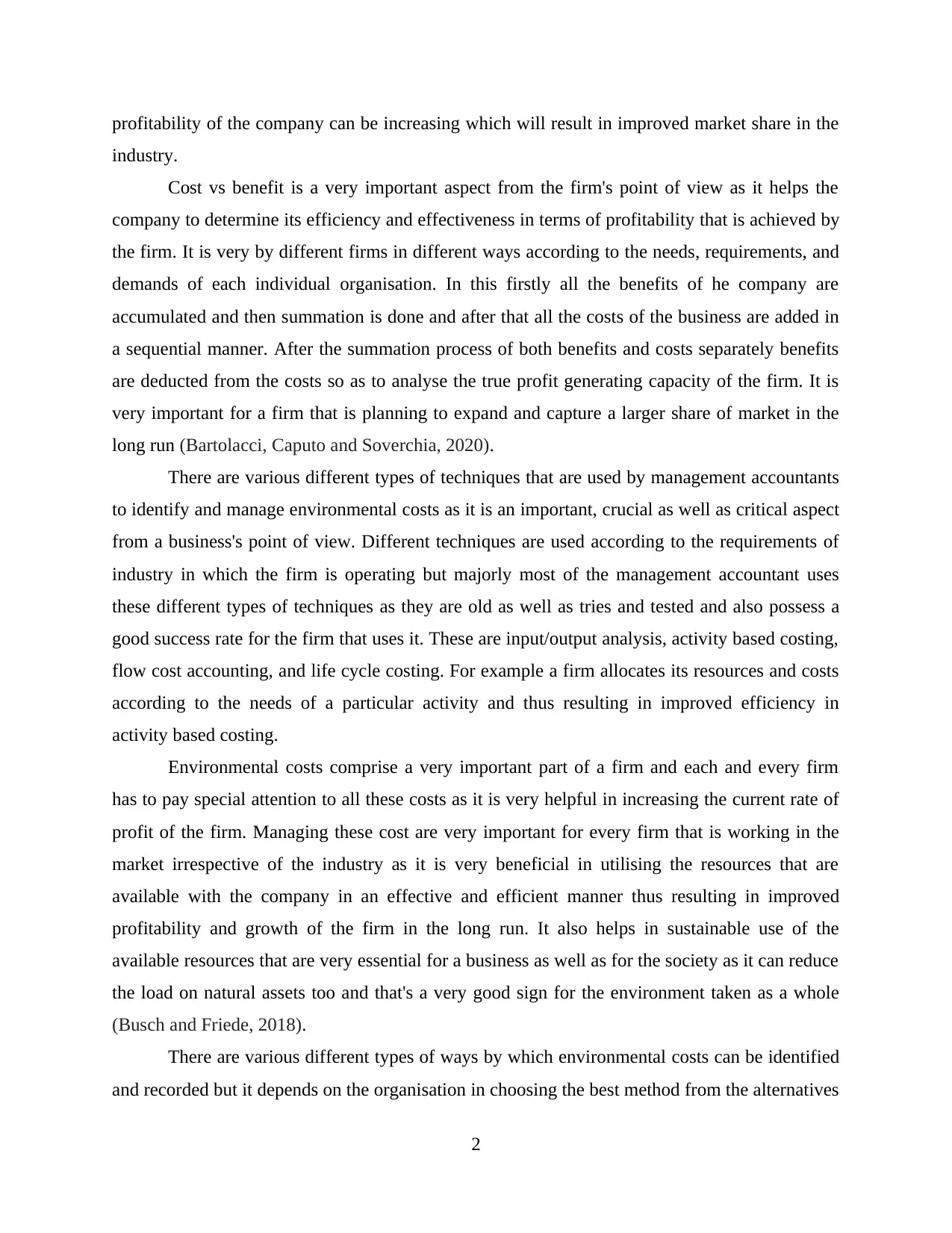
profitability of the company can be increasing which will result in improved market share in the
industry.
Cost vs benefit is a very important aspect from the firm's point of view as it helps the
company to determine its efficiency and effectiveness in terms of profitability that is achieved by
the firm. It is very by different firms in different ways according to the needs, requirements, and
demands of each individual organisation. In this firstly all the benefits of he company are
accumulated and then summation is done and after that all the costs of the business are added in
a sequential manner. After the summation process of both benefits and costs separately benefits
are deducted from the costs so as to analyse the true profit generating capacity of the firm. It is
very important for a firm that is planning to expand and capture a larger share of market in the
long run (Bartolacci, Caputo and Soverchia, 2020).
There are various different types of techniques that are used by management accountants
to identify and manage environmental costs as it is an important, crucial as well as critical aspect
from a business's point of view. Different techniques are used according to the requirements of
industry in which the firm is operating but majorly most of the management accountant uses
these different types of techniques as they are old as well as tries and tested and also possess a
good success rate for the firm that uses it. These are input/output analysis, activity based costing,
flow cost accounting, and life cycle costing. For example a firm allocates its resources and costs
according to the needs of a particular activity and thus resulting in improved efficiency in
activity based costing.
Environmental costs comprise a very important part of a firm and each and every firm
has to pay special attention to all these costs as it is very helpful in increasing the current rate of
profit of the firm. Managing these cost are very important for every firm that is working in the
market irrespective of the industry as it is very beneficial in utilising the resources that are
available with the company in an effective and efficient manner thus resulting in improved
profitability and growth of the firm in the long run. It also helps in sustainable use of the
available resources that are very essential for a business as well as for the society as it can reduce
the load on natural assets too and that's a very good sign for the environment taken as a whole
(Busch and Friede, 2018).
There are various different types of ways by which environmental costs can be identified
and recorded but it depends on the organisation in choosing the best method from the alternatives
2
industry.
Cost vs benefit is a very important aspect from the firm's point of view as it helps the
company to determine its efficiency and effectiveness in terms of profitability that is achieved by
the firm. It is very by different firms in different ways according to the needs, requirements, and
demands of each individual organisation. In this firstly all the benefits of he company are
accumulated and then summation is done and after that all the costs of the business are added in
a sequential manner. After the summation process of both benefits and costs separately benefits
are deducted from the costs so as to analyse the true profit generating capacity of the firm. It is
very important for a firm that is planning to expand and capture a larger share of market in the
long run (Bartolacci, Caputo and Soverchia, 2020).
There are various different types of techniques that are used by management accountants
to identify and manage environmental costs as it is an important, crucial as well as critical aspect
from a business's point of view. Different techniques are used according to the requirements of
industry in which the firm is operating but majorly most of the management accountant uses
these different types of techniques as they are old as well as tries and tested and also possess a
good success rate for the firm that uses it. These are input/output analysis, activity based costing,
flow cost accounting, and life cycle costing. For example a firm allocates its resources and costs
according to the needs of a particular activity and thus resulting in improved efficiency in
activity based costing.
Environmental costs comprise a very important part of a firm and each and every firm
has to pay special attention to all these costs as it is very helpful in increasing the current rate of
profit of the firm. Managing these cost are very important for every firm that is working in the
market irrespective of the industry as it is very beneficial in utilising the resources that are
available with the company in an effective and efficient manner thus resulting in improved
profitability and growth of the firm in the long run. It also helps in sustainable use of the
available resources that are very essential for a business as well as for the society as it can reduce
the load on natural assets too and that's a very good sign for the environment taken as a whole
(Busch and Friede, 2018).
There are various different types of ways by which environmental costs can be identified
and recorded but it depends on the organisation in choosing the best method from the alternatives
2
Paraphrase This Document
Need a fresh take? Get an instant paraphrase of this document with our AI Paraphraser
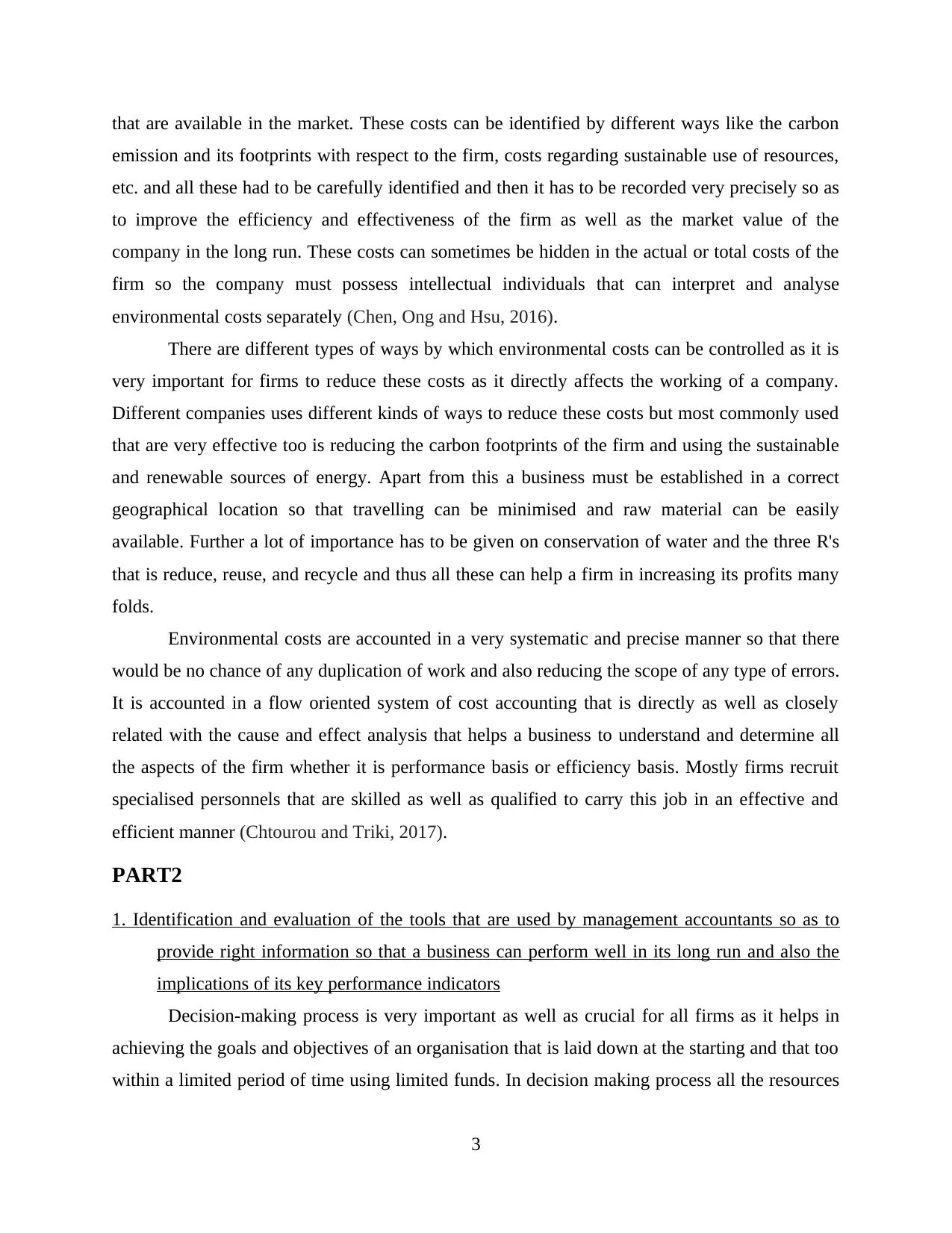
that are available in the market. These costs can be identified by different ways like the carbon
emission and its footprints with respect to the firm, costs regarding sustainable use of resources,
etc. and all these had to be carefully identified and then it has to be recorded very precisely so as
to improve the efficiency and effectiveness of the firm as well as the market value of the
company in the long run. These costs can sometimes be hidden in the actual or total costs of the
firm so the company must possess intellectual individuals that can interpret and analyse
environmental costs separately (Chen, Ong and Hsu, 2016).
There are different types of ways by which environmental costs can be controlled as it is
very important for firms to reduce these costs as it directly affects the working of a company.
Different companies uses different kinds of ways to reduce these costs but most commonly used
that are very effective too is reducing the carbon footprints of the firm and using the sustainable
and renewable sources of energy. Apart from this a business must be established in a correct
geographical location so that travelling can be minimised and raw material can be easily
available. Further a lot of importance has to be given on conservation of water and the three R's
that is reduce, reuse, and recycle and thus all these can help a firm in increasing its profits many
folds.
Environmental costs are accounted in a very systematic and precise manner so that there
would be no chance of any duplication of work and also reducing the scope of any type of errors.
It is accounted in a flow oriented system of cost accounting that is directly as well as closely
related with the cause and effect analysis that helps a business to understand and determine all
the aspects of the firm whether it is performance basis or efficiency basis. Mostly firms recruit
specialised personnels that are skilled as well as qualified to carry this job in an effective and
efficient manner (Chtourou and Triki, 2017).
PART2
1. Identification and evaluation of the tools that are used by management accountants so as to
provide right information so that a business can perform well in its long run and also the
implications of its key performance indicators
Decision-making process is very important as well as crucial for all firms as it helps in
achieving the goals and objectives of an organisation that is laid down at the starting and that too
within a limited period of time using limited funds. In decision making process all the resources
3
emission and its footprints with respect to the firm, costs regarding sustainable use of resources,
etc. and all these had to be carefully identified and then it has to be recorded very precisely so as
to improve the efficiency and effectiveness of the firm as well as the market value of the
company in the long run. These costs can sometimes be hidden in the actual or total costs of the
firm so the company must possess intellectual individuals that can interpret and analyse
environmental costs separately (Chen, Ong and Hsu, 2016).
There are different types of ways by which environmental costs can be controlled as it is
very important for firms to reduce these costs as it directly affects the working of a company.
Different companies uses different kinds of ways to reduce these costs but most commonly used
that are very effective too is reducing the carbon footprints of the firm and using the sustainable
and renewable sources of energy. Apart from this a business must be established in a correct
geographical location so that travelling can be minimised and raw material can be easily
available. Further a lot of importance has to be given on conservation of water and the three R's
that is reduce, reuse, and recycle and thus all these can help a firm in increasing its profits many
folds.
Environmental costs are accounted in a very systematic and precise manner so that there
would be no chance of any duplication of work and also reducing the scope of any type of errors.
It is accounted in a flow oriented system of cost accounting that is directly as well as closely
related with the cause and effect analysis that helps a business to understand and determine all
the aspects of the firm whether it is performance basis or efficiency basis. Mostly firms recruit
specialised personnels that are skilled as well as qualified to carry this job in an effective and
efficient manner (Chtourou and Triki, 2017).
PART2
1. Identification and evaluation of the tools that are used by management accountants so as to
provide right information so that a business can perform well in its long run and also the
implications of its key performance indicators
Decision-making process is very important as well as crucial for all firms as it helps in
achieving the goals and objectives of an organisation that is laid down at the starting and that too
within a limited period of time using limited funds. In decision making process all the resources
3
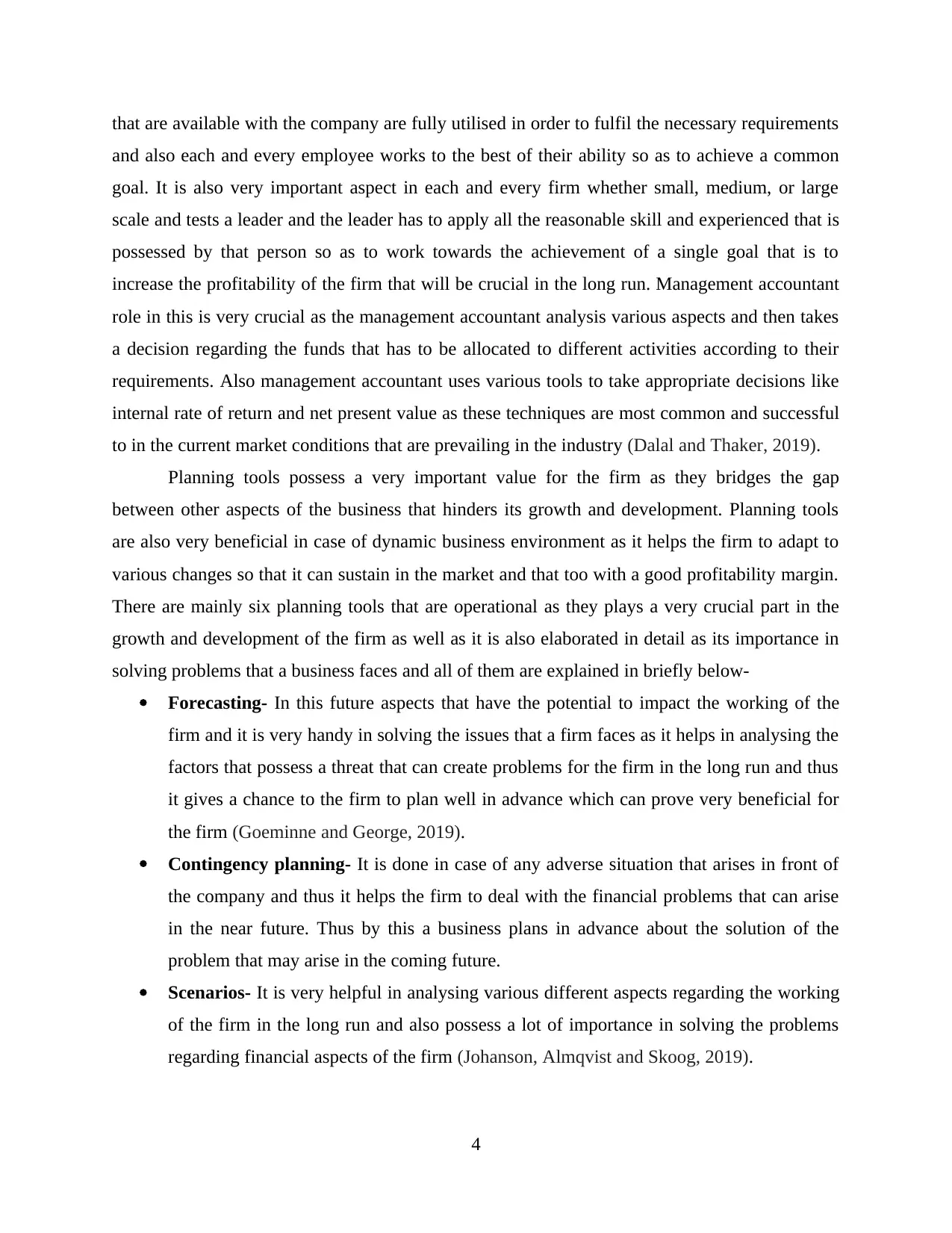
that are available with the company are fully utilised in order to fulfil the necessary requirements
and also each and every employee works to the best of their ability so as to achieve a common
goal. It is also very important aspect in each and every firm whether small, medium, or large
scale and tests a leader and the leader has to apply all the reasonable skill and experienced that is
possessed by that person so as to work towards the achievement of a single goal that is to
increase the profitability of the firm that will be crucial in the long run. Management accountant
role in this is very crucial as the management accountant analysis various aspects and then takes
a decision regarding the funds that has to be allocated to different activities according to their
requirements. Also management accountant uses various tools to take appropriate decisions like
internal rate of return and net present value as these techniques are most common and successful
to in the current market conditions that are prevailing in the industry (Dalal and Thaker, 2019).
Planning tools possess a very important value for the firm as they bridges the gap
between other aspects of the business that hinders its growth and development. Planning tools
are also very beneficial in case of dynamic business environment as it helps the firm to adapt to
various changes so that it can sustain in the market and that too with a good profitability margin.
There are mainly six planning tools that are operational as they plays a very crucial part in the
growth and development of the firm as well as it is also elaborated in detail as its importance in
solving problems that a business faces and all of them are explained in briefly below-
Forecasting- In this future aspects that have the potential to impact the working of the
firm and it is very handy in solving the issues that a firm faces as it helps in analysing the
factors that possess a threat that can create problems for the firm in the long run and thus
it gives a chance to the firm to plan well in advance which can prove very beneficial for
the firm (Goeminne and George, 2019).
Contingency planning- It is done in case of any adverse situation that arises in front of
the company and thus it helps the firm to deal with the financial problems that can arise
in the near future. Thus by this a business plans in advance about the solution of the
problem that may arise in the coming future.
Scenarios- It is very helpful in analysing various different aspects regarding the working
of the firm in the long run and also possess a lot of importance in solving the problems
regarding financial aspects of the firm (Johanson, Almqvist and Skoog, 2019).
4
and also each and every employee works to the best of their ability so as to achieve a common
goal. It is also very important aspect in each and every firm whether small, medium, or large
scale and tests a leader and the leader has to apply all the reasonable skill and experienced that is
possessed by that person so as to work towards the achievement of a single goal that is to
increase the profitability of the firm that will be crucial in the long run. Management accountant
role in this is very crucial as the management accountant analysis various aspects and then takes
a decision regarding the funds that has to be allocated to different activities according to their
requirements. Also management accountant uses various tools to take appropriate decisions like
internal rate of return and net present value as these techniques are most common and successful
to in the current market conditions that are prevailing in the industry (Dalal and Thaker, 2019).
Planning tools possess a very important value for the firm as they bridges the gap
between other aspects of the business that hinders its growth and development. Planning tools
are also very beneficial in case of dynamic business environment as it helps the firm to adapt to
various changes so that it can sustain in the market and that too with a good profitability margin.
There are mainly six planning tools that are operational as they plays a very crucial part in the
growth and development of the firm as well as it is also elaborated in detail as its importance in
solving problems that a business faces and all of them are explained in briefly below-
Forecasting- In this future aspects that have the potential to impact the working of the
firm and it is very handy in solving the issues that a firm faces as it helps in analysing the
factors that possess a threat that can create problems for the firm in the long run and thus
it gives a chance to the firm to plan well in advance which can prove very beneficial for
the firm (Goeminne and George, 2019).
Contingency planning- It is done in case of any adverse situation that arises in front of
the company and thus it helps the firm to deal with the financial problems that can arise
in the near future. Thus by this a business plans in advance about the solution of the
problem that may arise in the coming future.
Scenarios- It is very helpful in analysing various different aspects regarding the working
of the firm in the long run and also possess a lot of importance in solving the problems
regarding financial aspects of the firm (Johanson, Almqvist and Skoog, 2019).
4
⊘ This is a preview!⊘
Do you want full access?
Subscribe today to unlock all pages.

Trusted by 1+ million students worldwide
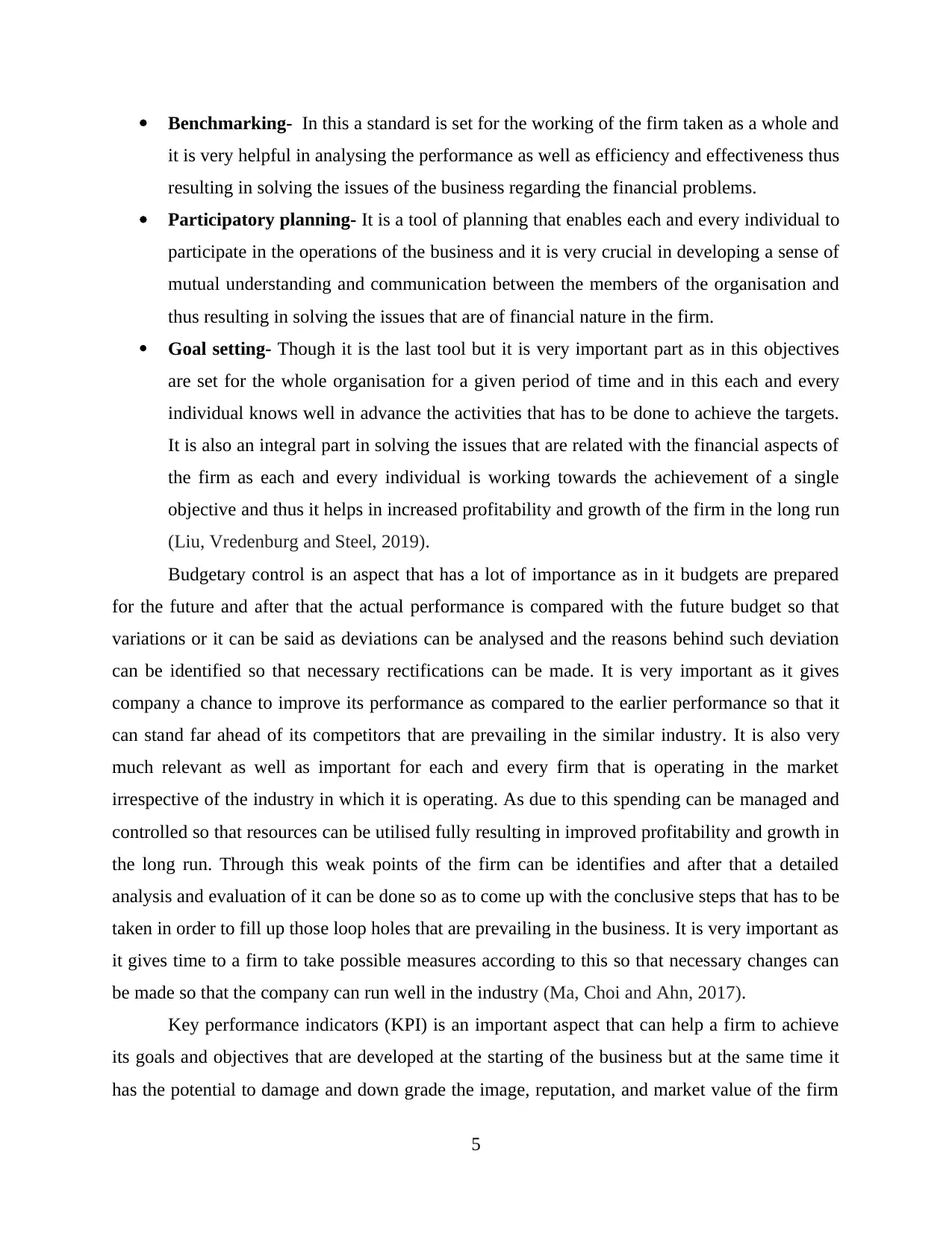
Benchmarking- In this a standard is set for the working of the firm taken as a whole and
it is very helpful in analysing the performance as well as efficiency and effectiveness thus
resulting in solving the issues of the business regarding the financial problems.
Participatory planning- It is a tool of planning that enables each and every individual to
participate in the operations of the business and it is very crucial in developing a sense of
mutual understanding and communication between the members of the organisation and
thus resulting in solving the issues that are of financial nature in the firm.
Goal setting- Though it is the last tool but it is very important part as in this objectives
are set for the whole organisation for a given period of time and in this each and every
individual knows well in advance the activities that has to be done to achieve the targets.
It is also an integral part in solving the issues that are related with the financial aspects of
the firm as each and every individual is working towards the achievement of a single
objective and thus it helps in increased profitability and growth of the firm in the long run
(Liu, Vredenburg and Steel, 2019).
Budgetary control is an aspect that has a lot of importance as in it budgets are prepared
for the future and after that the actual performance is compared with the future budget so that
variations or it can be said as deviations can be analysed and the reasons behind such deviation
can be identified so that necessary rectifications can be made. It is very important as it gives
company a chance to improve its performance as compared to the earlier performance so that it
can stand far ahead of its competitors that are prevailing in the similar industry. It is also very
much relevant as well as important for each and every firm that is operating in the market
irrespective of the industry in which it is operating. As due to this spending can be managed and
controlled so that resources can be utilised fully resulting in improved profitability and growth in
the long run. Through this weak points of the firm can be identifies and after that a detailed
analysis and evaluation of it can be done so as to come up with the conclusive steps that has to be
taken in order to fill up those loop holes that are prevailing in the business. It is very important as
it gives time to a firm to take possible measures according to this so that necessary changes can
be made so that the company can run well in the industry (Ma, Choi and Ahn, 2017).
Key performance indicators (KPI) is an important aspect that can help a firm to achieve
its goals and objectives that are developed at the starting of the business but at the same time it
has the potential to damage and down grade the image, reputation, and market value of the firm
5
it is very helpful in analysing the performance as well as efficiency and effectiveness thus
resulting in solving the issues of the business regarding the financial problems.
Participatory planning- It is a tool of planning that enables each and every individual to
participate in the operations of the business and it is very crucial in developing a sense of
mutual understanding and communication between the members of the organisation and
thus resulting in solving the issues that are of financial nature in the firm.
Goal setting- Though it is the last tool but it is very important part as in this objectives
are set for the whole organisation for a given period of time and in this each and every
individual knows well in advance the activities that has to be done to achieve the targets.
It is also an integral part in solving the issues that are related with the financial aspects of
the firm as each and every individual is working towards the achievement of a single
objective and thus it helps in increased profitability and growth of the firm in the long run
(Liu, Vredenburg and Steel, 2019).
Budgetary control is an aspect that has a lot of importance as in it budgets are prepared
for the future and after that the actual performance is compared with the future budget so that
variations or it can be said as deviations can be analysed and the reasons behind such deviation
can be identified so that necessary rectifications can be made. It is very important as it gives
company a chance to improve its performance as compared to the earlier performance so that it
can stand far ahead of its competitors that are prevailing in the similar industry. It is also very
much relevant as well as important for each and every firm that is operating in the market
irrespective of the industry in which it is operating. As due to this spending can be managed and
controlled so that resources can be utilised fully resulting in improved profitability and growth in
the long run. Through this weak points of the firm can be identifies and after that a detailed
analysis and evaluation of it can be done so as to come up with the conclusive steps that has to be
taken in order to fill up those loop holes that are prevailing in the business. It is very important as
it gives time to a firm to take possible measures according to this so that necessary changes can
be made so that the company can run well in the industry (Ma, Choi and Ahn, 2017).
Key performance indicators (KPI) is an important aspect that can help a firm to achieve
its goals and objectives that are developed at the starting of the business but at the same time it
has the potential to damage and down grade the image, reputation, and market value of the firm
5
Paraphrase This Document
Need a fresh take? Get an instant paraphrase of this document with our AI Paraphraser
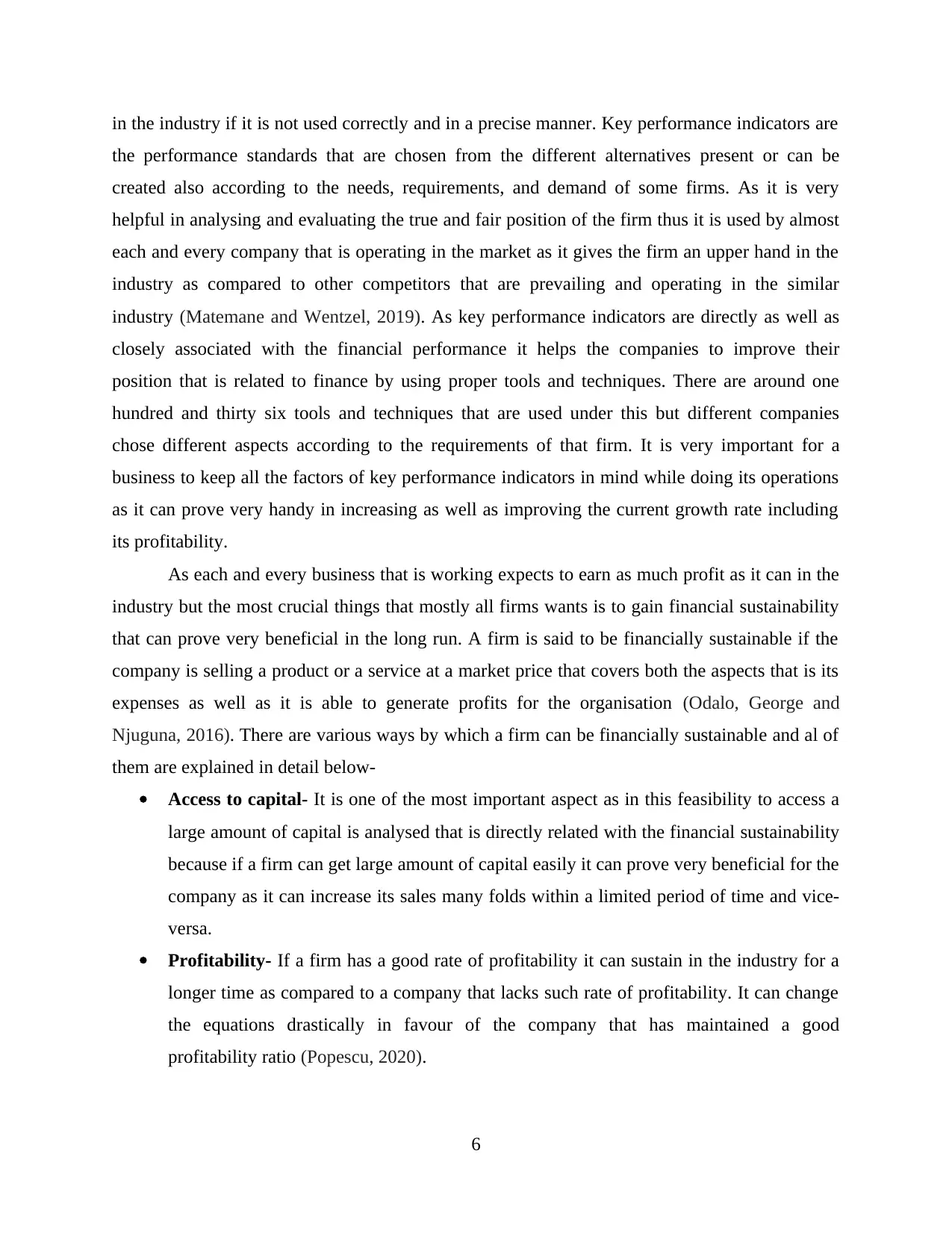
in the industry if it is not used correctly and in a precise manner. Key performance indicators are
the performance standards that are chosen from the different alternatives present or can be
created also according to the needs, requirements, and demand of some firms. As it is very
helpful in analysing and evaluating the true and fair position of the firm thus it is used by almost
each and every company that is operating in the market as it gives the firm an upper hand in the
industry as compared to other competitors that are prevailing and operating in the similar
industry (Matemane and Wentzel, 2019). As key performance indicators are directly as well as
closely associated with the financial performance it helps the companies to improve their
position that is related to finance by using proper tools and techniques. There are around one
hundred and thirty six tools and techniques that are used under this but different companies
chose different aspects according to the requirements of that firm. It is very important for a
business to keep all the factors of key performance indicators in mind while doing its operations
as it can prove very handy in increasing as well as improving the current growth rate including
its profitability.
As each and every business that is working expects to earn as much profit as it can in the
industry but the most crucial things that mostly all firms wants is to gain financial sustainability
that can prove very beneficial in the long run. A firm is said to be financially sustainable if the
company is selling a product or a service at a market price that covers both the aspects that is its
expenses as well as it is able to generate profits for the organisation (Odalo, George and
Njuguna, 2016). There are various ways by which a firm can be financially sustainable and al of
them are explained in detail below-
Access to capital- It is one of the most important aspect as in this feasibility to access a
large amount of capital is analysed that is directly related with the financial sustainability
because if a firm can get large amount of capital easily it can prove very beneficial for the
company as it can increase its sales many folds within a limited period of time and vice-
versa.
Profitability- If a firm has a good rate of profitability it can sustain in the industry for a
longer time as compared to a company that lacks such rate of profitability. It can change
the equations drastically in favour of the company that has maintained a good
profitability ratio (Popescu, 2020).
6
the performance standards that are chosen from the different alternatives present or can be
created also according to the needs, requirements, and demand of some firms. As it is very
helpful in analysing and evaluating the true and fair position of the firm thus it is used by almost
each and every company that is operating in the market as it gives the firm an upper hand in the
industry as compared to other competitors that are prevailing and operating in the similar
industry (Matemane and Wentzel, 2019). As key performance indicators are directly as well as
closely associated with the financial performance it helps the companies to improve their
position that is related to finance by using proper tools and techniques. There are around one
hundred and thirty six tools and techniques that are used under this but different companies
chose different aspects according to the requirements of that firm. It is very important for a
business to keep all the factors of key performance indicators in mind while doing its operations
as it can prove very handy in increasing as well as improving the current growth rate including
its profitability.
As each and every business that is working expects to earn as much profit as it can in the
industry but the most crucial things that mostly all firms wants is to gain financial sustainability
that can prove very beneficial in the long run. A firm is said to be financially sustainable if the
company is selling a product or a service at a market price that covers both the aspects that is its
expenses as well as it is able to generate profits for the organisation (Odalo, George and
Njuguna, 2016). There are various ways by which a firm can be financially sustainable and al of
them are explained in detail below-
Access to capital- It is one of the most important aspect as in this feasibility to access a
large amount of capital is analysed that is directly related with the financial sustainability
because if a firm can get large amount of capital easily it can prove very beneficial for the
company as it can increase its sales many folds within a limited period of time and vice-
versa.
Profitability- If a firm has a good rate of profitability it can sustain in the industry for a
longer time as compared to a company that lacks such rate of profitability. It can change
the equations drastically in favour of the company that has maintained a good
profitability ratio (Popescu, 2020).
6
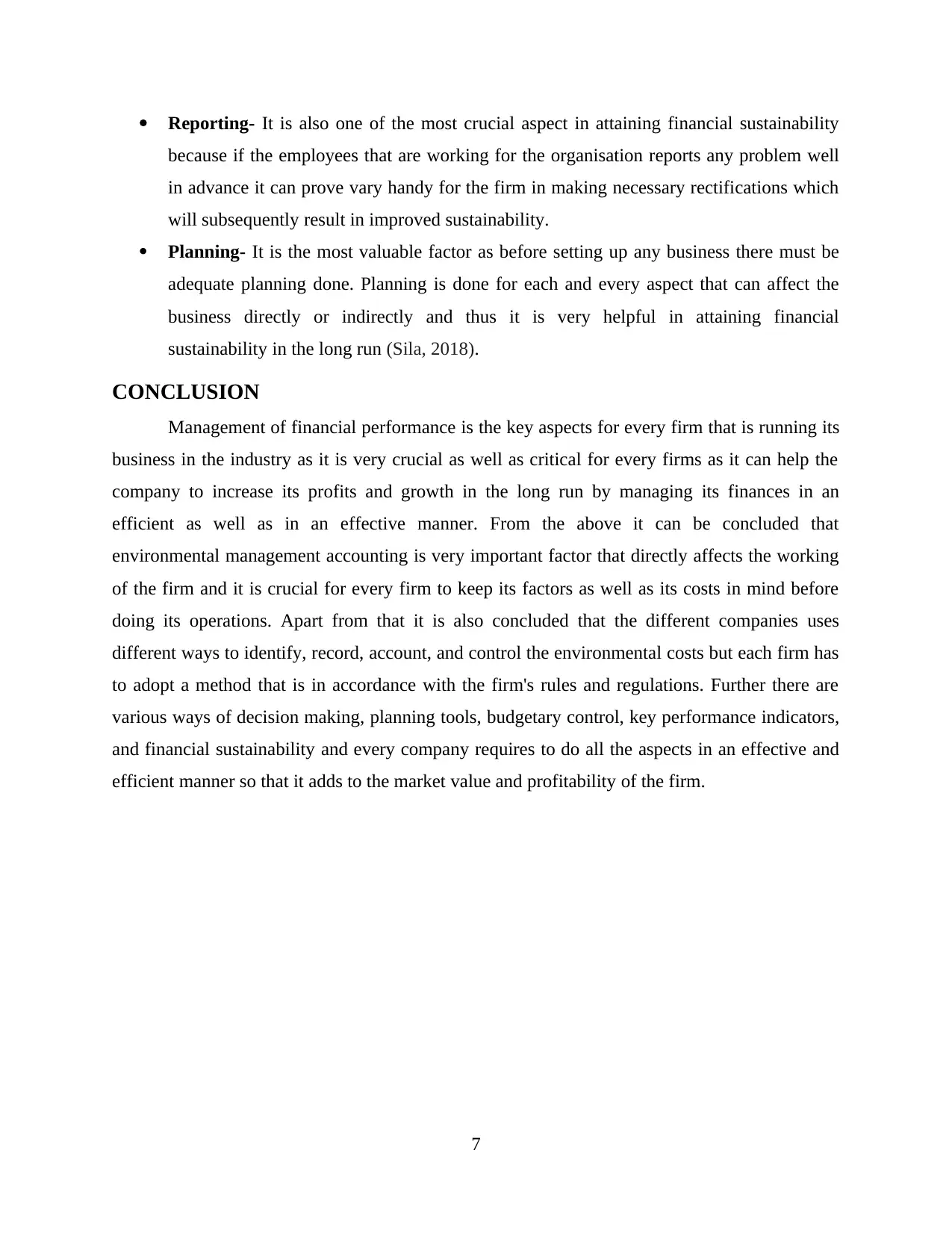
Reporting- It is also one of the most crucial aspect in attaining financial sustainability
because if the employees that are working for the organisation reports any problem well
in advance it can prove vary handy for the firm in making necessary rectifications which
will subsequently result in improved sustainability.
Planning- It is the most valuable factor as before setting up any business there must be
adequate planning done. Planning is done for each and every aspect that can affect the
business directly or indirectly and thus it is very helpful in attaining financial
sustainability in the long run (Sila, 2018).
CONCLUSION
Management of financial performance is the key aspects for every firm that is running its
business in the industry as it is very crucial as well as critical for every firms as it can help the
company to increase its profits and growth in the long run by managing its finances in an
efficient as well as in an effective manner. From the above it can be concluded that
environmental management accounting is very important factor that directly affects the working
of the firm and it is crucial for every firm to keep its factors as well as its costs in mind before
doing its operations. Apart from that it is also concluded that the different companies uses
different ways to identify, record, account, and control the environmental costs but each firm has
to adopt a method that is in accordance with the firm's rules and regulations. Further there are
various ways of decision making, planning tools, budgetary control, key performance indicators,
and financial sustainability and every company requires to do all the aspects in an effective and
efficient manner so that it adds to the market value and profitability of the firm.
7
because if the employees that are working for the organisation reports any problem well
in advance it can prove vary handy for the firm in making necessary rectifications which
will subsequently result in improved sustainability.
Planning- It is the most valuable factor as before setting up any business there must be
adequate planning done. Planning is done for each and every aspect that can affect the
business directly or indirectly and thus it is very helpful in attaining financial
sustainability in the long run (Sila, 2018).
CONCLUSION
Management of financial performance is the key aspects for every firm that is running its
business in the industry as it is very crucial as well as critical for every firms as it can help the
company to increase its profits and growth in the long run by managing its finances in an
efficient as well as in an effective manner. From the above it can be concluded that
environmental management accounting is very important factor that directly affects the working
of the firm and it is crucial for every firm to keep its factors as well as its costs in mind before
doing its operations. Apart from that it is also concluded that the different companies uses
different ways to identify, record, account, and control the environmental costs but each firm has
to adopt a method that is in accordance with the firm's rules and regulations. Further there are
various ways of decision making, planning tools, budgetary control, key performance indicators,
and financial sustainability and every company requires to do all the aspects in an effective and
efficient manner so that it adds to the market value and profitability of the firm.
7
⊘ This is a preview!⊘
Do you want full access?
Subscribe today to unlock all pages.

Trusted by 1+ million students worldwide
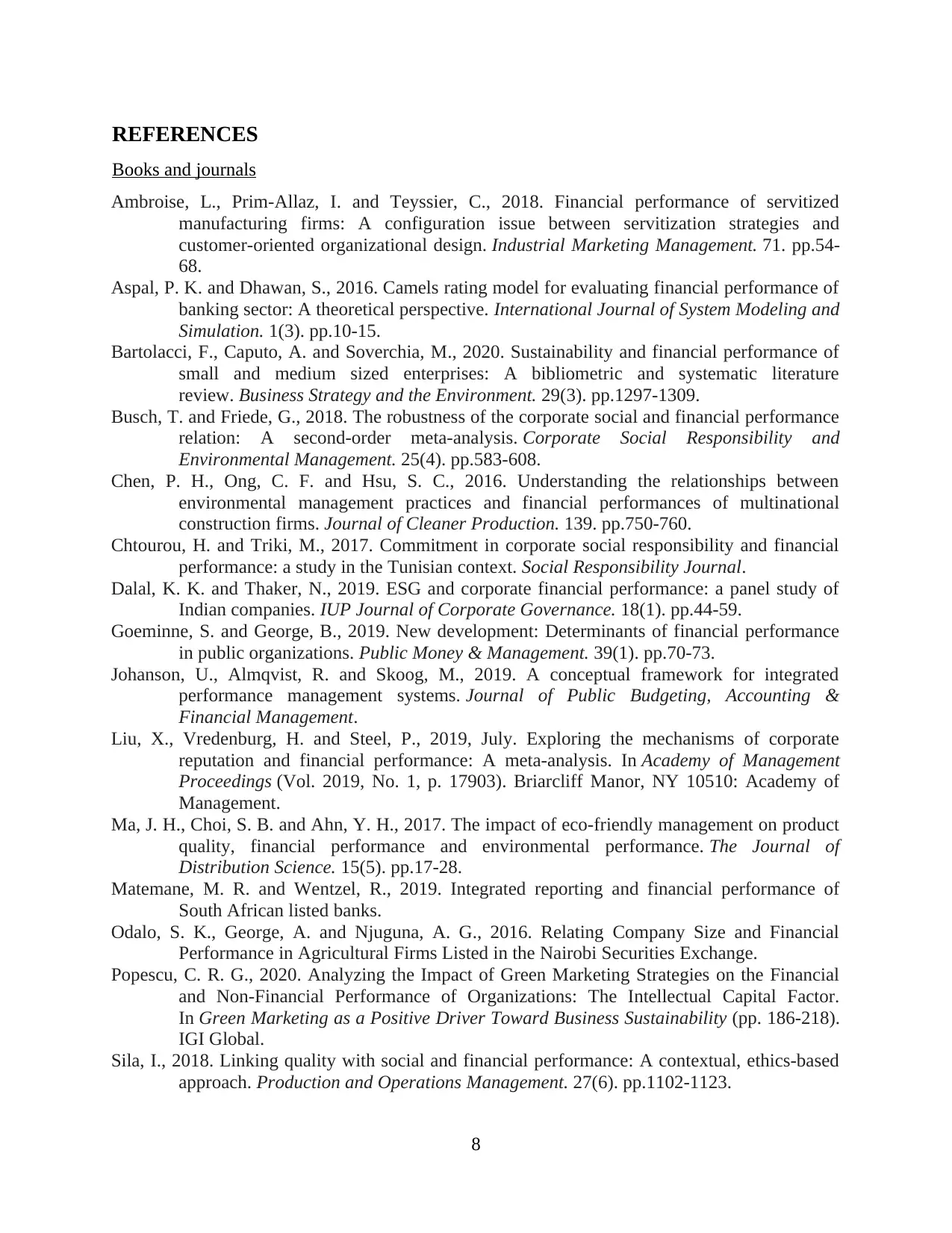
REFERENCES
Books and journals
Ambroise, L., Prim-Allaz, I. and Teyssier, C., 2018. Financial performance of servitized
manufacturing firms: A configuration issue between servitization strategies and
customer-oriented organizational design. Industrial Marketing Management. 71. pp.54-
68.
Aspal, P. K. and Dhawan, S., 2016. Camels rating model for evaluating financial performance of
banking sector: A theoretical perspective. International Journal of System Modeling and
Simulation. 1(3). pp.10-15.
Bartolacci, F., Caputo, A. and Soverchia, M., 2020. Sustainability and financial performance of
small and medium sized enterprises: A bibliometric and systematic literature
review. Business Strategy and the Environment. 29(3). pp.1297-1309.
Busch, T. and Friede, G., 2018. The robustness of the corporate social and financial performance
relation: A second‐order meta‐analysis. Corporate Social Responsibility and
Environmental Management. 25(4). pp.583-608.
Chen, P. H., Ong, C. F. and Hsu, S. C., 2016. Understanding the relationships between
environmental management practices and financial performances of multinational
construction firms. Journal of Cleaner Production. 139. pp.750-760.
Chtourou, H. and Triki, M., 2017. Commitment in corporate social responsibility and financial
performance: a study in the Tunisian context. Social Responsibility Journal.
Dalal, K. K. and Thaker, N., 2019. ESG and corporate financial performance: a panel study of
Indian companies. IUP Journal of Corporate Governance. 18(1). pp.44-59.
Goeminne, S. and George, B., 2019. New development: Determinants of financial performance
in public organizations. Public Money & Management. 39(1). pp.70-73.
Johanson, U., Almqvist, R. and Skoog, M., 2019. A conceptual framework for integrated
performance management systems. Journal of Public Budgeting, Accounting &
Financial Management.
Liu, X., Vredenburg, H. and Steel, P., 2019, July. Exploring the mechanisms of corporate
reputation and financial performance: A meta-analysis. In Academy of Management
Proceedings (Vol. 2019, No. 1, p. 17903). Briarcliff Manor, NY 10510: Academy of
Management.
Ma, J. H., Choi, S. B. and Ahn, Y. H., 2017. The impact of eco-friendly management on product
quality, financial performance and environmental performance. The Journal of
Distribution Science. 15(5). pp.17-28.
Matemane, M. R. and Wentzel, R., 2019. Integrated reporting and financial performance of
South African listed banks.
Odalo, S. K., George, A. and Njuguna, A. G., 2016. Relating Company Size and Financial
Performance in Agricultural Firms Listed in the Nairobi Securities Exchange.
Popescu, C. R. G., 2020. Analyzing the Impact of Green Marketing Strategies on the Financial
and Non-Financial Performance of Organizations: The Intellectual Capital Factor.
In Green Marketing as a Positive Driver Toward Business Sustainability (pp. 186-218).
IGI Global.
Sila, I., 2018. Linking quality with social and financial performance: A contextual, ethics‐based
approach. Production and Operations Management. 27(6). pp.1102-1123.
8
Books and journals
Ambroise, L., Prim-Allaz, I. and Teyssier, C., 2018. Financial performance of servitized
manufacturing firms: A configuration issue between servitization strategies and
customer-oriented organizational design. Industrial Marketing Management. 71. pp.54-
68.
Aspal, P. K. and Dhawan, S., 2016. Camels rating model for evaluating financial performance of
banking sector: A theoretical perspective. International Journal of System Modeling and
Simulation. 1(3). pp.10-15.
Bartolacci, F., Caputo, A. and Soverchia, M., 2020. Sustainability and financial performance of
small and medium sized enterprises: A bibliometric and systematic literature
review. Business Strategy and the Environment. 29(3). pp.1297-1309.
Busch, T. and Friede, G., 2018. The robustness of the corporate social and financial performance
relation: A second‐order meta‐analysis. Corporate Social Responsibility and
Environmental Management. 25(4). pp.583-608.
Chen, P. H., Ong, C. F. and Hsu, S. C., 2016. Understanding the relationships between
environmental management practices and financial performances of multinational
construction firms. Journal of Cleaner Production. 139. pp.750-760.
Chtourou, H. and Triki, M., 2017. Commitment in corporate social responsibility and financial
performance: a study in the Tunisian context. Social Responsibility Journal.
Dalal, K. K. and Thaker, N., 2019. ESG and corporate financial performance: a panel study of
Indian companies. IUP Journal of Corporate Governance. 18(1). pp.44-59.
Goeminne, S. and George, B., 2019. New development: Determinants of financial performance
in public organizations. Public Money & Management. 39(1). pp.70-73.
Johanson, U., Almqvist, R. and Skoog, M., 2019. A conceptual framework for integrated
performance management systems. Journal of Public Budgeting, Accounting &
Financial Management.
Liu, X., Vredenburg, H. and Steel, P., 2019, July. Exploring the mechanisms of corporate
reputation and financial performance: A meta-analysis. In Academy of Management
Proceedings (Vol. 2019, No. 1, p. 17903). Briarcliff Manor, NY 10510: Academy of
Management.
Ma, J. H., Choi, S. B. and Ahn, Y. H., 2017. The impact of eco-friendly management on product
quality, financial performance and environmental performance. The Journal of
Distribution Science. 15(5). pp.17-28.
Matemane, M. R. and Wentzel, R., 2019. Integrated reporting and financial performance of
South African listed banks.
Odalo, S. K., George, A. and Njuguna, A. G., 2016. Relating Company Size and Financial
Performance in Agricultural Firms Listed in the Nairobi Securities Exchange.
Popescu, C. R. G., 2020. Analyzing the Impact of Green Marketing Strategies on the Financial
and Non-Financial Performance of Organizations: The Intellectual Capital Factor.
In Green Marketing as a Positive Driver Toward Business Sustainability (pp. 186-218).
IGI Global.
Sila, I., 2018. Linking quality with social and financial performance: A contextual, ethics‐based
approach. Production and Operations Management. 27(6). pp.1102-1123.
8
Paraphrase This Document
Need a fresh take? Get an instant paraphrase of this document with our AI Paraphraser

9
1 out of 11
Related Documents
Your All-in-One AI-Powered Toolkit for Academic Success.
+13062052269
info@desklib.com
Available 24*7 on WhatsApp / Email
![[object Object]](/_next/static/media/star-bottom.7253800d.svg)
Unlock your academic potential
Copyright © 2020–2025 A2Z Services. All Rights Reserved. Developed and managed by ZUCOL.





